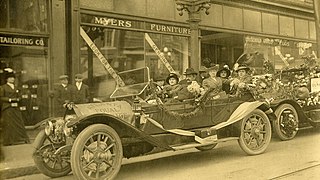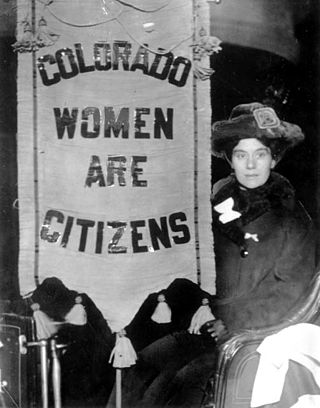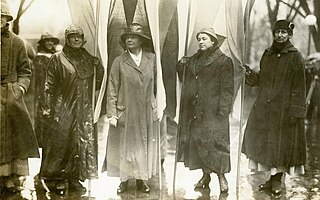
Women's suffrage was established in the United States on a full or partial basis by various towns, counties, states, and territories during the latter decades of the 19th century and early part of the 20th century. As women received the right to vote in some places, they began running for public office and gaining positions as school board members, county clerks, state legislators, judges, and, in the case of Jeannette Rankin, as a member of Congress.

This is a timeline of women's suffrage in Rhode Island. Women's suffrage in Rhode Island started with women's rights activities, such as convention planning and publications of women's rights journals. The first women's suffrage group in Rhode Island was founded in 1868. A women's suffrage amendment was decided by referendum on April 6, 1887, but it failed by a large amount. Finally, in 1917, Rhode Island women gained the right to vote in presidential elections. On January 6, 1920, Rhode Island became the twenty-fourth state to ratify the Nineteenth Amendment.

This is a timeline of women's suffrage in Virginia. While there were some very early efforts to support women's suffrage in Virginia, most of the activism for the vote for women occurred early in the 20th century. The Equal Suffrage League of Virginia was formed in 1909 and the Virginia Branch of the Congressional Union for Woman Suffrage was formed in 1915. Over the next years, women held rallies, conventions and many propositions for women's suffrage were introduced in the Virginia General Assembly. Virginia didn't ratify the Nineteenth Amendment until 1952. Native American women could not have a full vote until 1924 and African American women were effectively disenfranchised until the Voting Rights Act passed in 1965.

This is a timeline of women's suffrage in Georgia. Women's suffrage in Georgia started in earnest with the formation of the Georgia Woman Suffrage Association (GWSA) in 1892. GWSA helped bring the first large women's rights convention to the South in 1895 when the National American Woman's Suffrage Association (NAWSA) held their convention in Atlanta. GWSA was the main source of activism behind women's suffrage until 1913. In that year, several other groups formed including the Georgia Young People's Suffrage Association (GYPSA) and the Georgia Men's League for Woman Suffrage. In 1914, the Georgia Association Opposed to Women's Suffrage (GAOWS) was formed by anti-suffragists. Despite the hard work by suffragists in Georgia, the state continued to reject most efforts to pass equal suffrage. In 1917, Waycross, Georgia allowed women to vote in primary elections and in 1919 Atlanta granted the same. Georgia was the first state to reject the Nineteenth Amendment. Women in Georgia still had to wait to vote statewide after the Nineteenth Amendment was ratified on August 26, 1920. Native American and African American women had to wait even longer to vote. Georgia ratified the Nineteenth Amendment in 1970.

Women's suffrage began in Illinois began in the mid-1850s. The first women's suffrage group was formed in Earlville, Illinois, by the cousin of Susan B. Anthony, Susan Hoxie Richardson. After the Civil War, former abolitionist Mary Livermore organized the Illinois Woman Suffrage Association (IWSA), which would later be renamed the Illinois Equal Suffrage Association (IESA). Frances Willard and other suffragists in the IESA worked to lobby various government entities for women's suffrage. In the 1870s, women were allowed to serve on school boards and were elected to that office. The first women to vote in Illinois were 15 women in Lombard, Illinois, led by Ellen A. Martin, who found a loophole in the law in 1891. Women were eventually allowed to vote for school offices in the 1890s. Women in Chicago and throughout Illinois fought for the right to vote based on the idea of no taxation without representation. They also continued to expand their efforts throughout the state. In 1913, women in Illinois were successful in gaining partial suffrage. They became the first women east of the Mississippi River to have the right to vote in presidential elections. Suffragists then worked to register women to vote. Both African-American and white suffragists registered women in huge numbers. In Chicago alone 200,000 women were registered to vote. After gaining partial suffrage, women in Illinois kept working towards full suffrage. The state became the first to ratify the Nineteenth Amendment, passing the ratification on June 10, 1919. The League of Women Voters (LWV) was announced in Chicago on February 14, 1920.

This is a timeline of women's suffrage in Illinois. Women's suffrage in Illinois began in the mid 1850s. The first women's suffrage group was created in 1855 in Earlville, Illinois by Susan Hoxie Richardson. The Illinois Woman Suffrage Association (IWSA), later renamed the Illinois Equal Suffrage Association (IESA), was created by Mary Livermore in 1869. This group held annual conventions and petitioned various governmental bodies in Illinois for women's suffrage. On June 19, 1891, women gained the right to vote for school offices. However, it wasn't until 1913 that women saw expanded suffrage. That year women in Illinois were granted the right to vote for Presidential electors and various local offices. Suffragists continued to fight for full suffrage in the state. Finally, Illinois became the first state to ratify the Nineteenth Amendment on June 10, 1919. The League of Women Voters (LWV) was announced in Chicago on February 14, 1920.

This is a timeline of women's suffrage in Alabama. Women's suffrage in Alabama starts in the late 1860s and grows over time in the 1890s. Much of the women's suffrage work stopped after 1901, only to pick up again in 1910. Alabama did not ratify the Nineteenth Amendment until 1953 and African-Americans and women were affected by poll taxes and other issues until the mid 1960s.

This is a timeline of women's suffrage in Delaware. Suffragists in Delaware began to fight for women's suffrage in the late 1860s. Mary Ann Sorden Stuart and national suffragists lobbied the Delaware General Assembly for women's suffrage. In 1896, the Delaware Equal Suffrage Association (DESA) was formed. Annual state suffrage conventions were held. There were also numerous attempts to pass an equal suffrage amendment to the Delaware State Constitution, but none were successful. In 1913, a state chapter of the Congressional Union (CU) was opened by Mabel Vernon. Delaware suffragists are involved in more militant tactics, including taking part of the Silent Sentinels. On March 22, 1920, Delaware had a special session of the General Assembly to consider ratification of the Nineteenth Amendment. It was not ratified by Delaware until 1923.

Women's suffrage began in Nevada began in the late 1860s. Lecturer and suffragist Laura de Force Gordon started giving women's suffrage speeches in the state starting in 1867. In 1869, Assemblyman Curtis J. Hillyer introduced a women's suffrage resolution in the Nevada Legislature. He also spoke out on women's rights. Hillyer's resolution passed, but like all proposed amendments to the state constitution, must pass one more time and then go out to a voter referendum. In 1870, Nevada held its first women's suffrage convention in Battle Mountain Station. In the late 1880s, women gained the right to run for school offices and the next year several women are elected to office. A few suffrage associations were formed in the mid 1890s, with a state group operating a few women's suffrage conventions. However, after 1899, most suffrage work slowed down or stopped altogether. In 1911, the Nevada Equal Franchise Society (NEFS) was formed. Attorney Felice Cohn wrote a women's suffrage resolution that was accepted and passed the Nevada Legislature. The resolution passed again in 1913 and will go out to the voters on November 3, 1914. Suffragists in the state organized heavily for the 1914 vote. Anne Henrietta Martin brought in suffragists and trade unionists from other states to help campaign. Martin and Mabel Vernon traveled around the state in a rented Ford Model T, covering thousands of miles. Suffragists in Nevada visited mining towns and even went down into mines to talk to voters. On November 3, the voters of Nevada voted overwhelmingly for women's suffrage. Even though Nevada women won the vote, they did not stop campaigning for women's suffrage. Nevada suffragists aided other states' campaigns and worked towards securing a federal suffrage amendment. On February 7, 1920, Nevada became the 28th state to ratify the Nineteenth Amendment.

This is a timeline of women's suffrage in Nevada. In 1869, Curtis J. Hillyer introduced a women's suffrage resolution in the Nevada Legislature which passed, though it would wait for another legislative session to approve a second time. The first women's suffrage convention took place in 1870 in Battle Mountain Station. Several women's suffrage resolutions are voted on, or approved, but none complete the criteria to become amendments to the Constitution of Nevada. In the 1880s, women gain the right to run for school offices and several women run and win. Some Nevada women's suffrage groups work throughout the 1890s and hold more conventions. However, most suffrage work slows down or stops around 1899. The Nevada Equal Franchise Society (NEFS) was created in 1911. That same year, Attorney Felice Cohn writes a women's suffrage resolution that is accepted and passed by the Nevada Legislature. Anne Henrietta Martin becomes president of NEFS in 1912. The next year, Cohn's resolution passes a second time and will go out as a voter referendum the next year. On November 3, 1914 Nevada voters approve women's suffrage. Women in Nevada continue to be involved in suffrage campaigning. On February 7, 1920 Nevada ratifies the Nineteenth Amendment.
This is a timeline of women's suffrage in Florida. Ella C. Chamberlain began women's suffrage efforts in Florida starting in 1892. However, after Chamberlain leaves the state in 1897, suffrage work largely ceases until the next century. More women's suffrage groups are organized, with the first in the twentieth century being the Equal Franchise League in Jacksonville, Florida in 1912. Additional groups are created around Florida, including a Men's Equal Suffrage League of Florida. Suffragists lobby the Florida Legislature for equal suffrage, hold conventions, and educate voters. Several cities in Florida pass laws allowing women to vote in municipal elections, with Fellsmere being the first in 1915. Zena Dreier becomes the first woman to legally cast a vote in the South on June 19, 1915. On May 26, 1919, women in Orlando vote for the first time. After the passage of the Nineteenth Amendment, Helen Hunt West becomes the first woman in Florida to register to vote under equal franchise rules on September 7, 1920. Florida does not ratify the Nineteenth Amendment until May 13, 1969.

This is a timeline of women's suffrage in Arizona. The first women's suffrage bill was brought forward in the Arizona Territorial legislature in 1883, but it did not pass. Suffragists work to influence the Territorial Constitutional Convention in 1891 and lose the women's suffrage battle by only three votes. That year, the Arizona Suffrage Association is formed. In 1897, taxpaying women gain the right to vote in school board elections. Suffragists both from Arizona and around the country continue to lobby the territorial legislature and organize women's suffrage groups. In 1903, a women's suffrage bill passes, but is vetoed by the governor. In 1910, suffragists work to influence the Arizona State Constitutional Convention, but are also unsuccessful. When Arizona becomes a state on February 14, 1912, an attempt to legislate a women's suffrage amendment to the Arizona Constitution fails. Frances Munds mounts a successful ballot initiative campaign. On November 5, 1912, women's suffrage passes in Arizona. In 1913, the voter registration books are opened to women. In 1914, women participate in their first primary elections. Arizona ratified the Nineteenth Amendment on February 12, 1920. However, Native American women and Latinas would wait longer for full voting rights.

This is a timeline of women's suffrage in Maine. Suffragists began campaigning in Maine in the mid 1850s. A lecture series was started by Ann F. Jarvis Greely and other women in Ellsworth, Maine in 1857. The first women's suffrage petition to the Maine Legislature was sent that same year. Women continue to fight for equal suffrage throughout the 1860s and 1870s. The Maine Woman Suffrage Association (MWSA) is established in 1873 and the next year, the first Woman's Christian Temperance Union (WCTU) chapter was started. In 1887, the Maine Legislature votes on a women's suffrage amendment to the state constitution, but it does not receive the necessary two-thirds vote. Additional attempts to pass women's suffrage legislation receives similar treatment throughout the rest of the century. In the twentieth century, suffragists continue to organize and meet. Several suffrage groups form, including the Maine chapter of the College Equal Suffrage League in 1914 and the Men's Equal Suffrage League of Maine in 1914. In 1917, a voter referendum on women's suffrage is scheduled for September 10, but fails at the polls. On November 5, 1919 Maine ratifies the Nineteenth Amendment. On September 13, 1920, most women in Maine are able to vote. Native Americans in Maine are barred from voting for many years. In 1924, Native Americans became American citizens. In 1954, a voter referendum for Native American voting rights passes. The next year, Lucy Nicolar Poolaw (Penobscot), is the Native American living on an Indian reservation to cast a vote.

This is a timeline of women's suffrage in Colorado. Women's suffrage efforts started in the late 1860s. During the state constitutional convention for Colorado, women received a small win when they were granted the right to vote in school board elections. In 1877, the first women's suffrage referendum was defeated. In 1893, another referendum was successful. After winning the right to vote, Colorado women continued to fight for a federal women's suffrage amendment. While most women were able to vote, it wasn't until 1970 that Native Americans living on reservations were enfranchised.

Women's suffrage began in North Dakota when it was still part of the Dakota Territory. During this time activists worked for women's suffrage, and in 1879, women gained the right to vote at school meetings. This was formalized in 1883 when the legislature passed a law where women would use separate ballots for their votes on school-related issues. When North Dakota was writing its state constitution, efforts were made to include equal suffrage for women, but women were only able to retain their right to vote for school issues. An abortive effort to provide equal suffrage happened in 1893, when the state legislature passed equal suffrage for women. However, the bill was "lost," never signed and eventually expunged from the record. Suffragists continued to hold conventions, raise awareness, and form organizations. The arrival of Sylvia Pankhurst in February 1912 stimulated the creation of more groups, including the statewide Votes for Women League. In 1914, there was a voter referendum on women's suffrage, but it did not pass. In 1917, limited suffrage bills for municipal and presidential suffrage were signed into law. On December 1, 1919, North Dakota became the twentieth state to ratify the Nineteenth Amendment.

This is a timeline of women's suffrage in North Dakota. Women's suffrage in North Dakota began while it was still part of the Dakota Territory. In 1879, women in the territory gained the right to vote in school meetings. Later, this was more formalized in 1883, providing women separate ballots for school issues. After North Dakota was a state, suffragists continued to work for full suffrage. A referendum on equal suffrage took place in 1914, but failed. In 1917, women gained the right to vote in municipal and presidential elections. On December 1, 1919, North Dakota became the 20th state to ratify the Nineteenth Amendment.

This is a timeline of women's suffrage in South Dakota. The early history of women's suffrage in the state is shared with North Dakota. When South Dakota became a state, it held a voter referendum in 1890 on an equal suffrage amendment. This effort failed, but suffragists continued to organize and lobby the legislature to pass voter referendums. None passed until 1918. South Dakota ratified the Nineteenth Amendment on December 4, 1919.

This is a timeline of women's suffrage in Iowa. Women's suffrage work started early in Iowa's history. Organizing began in the late 1960s with the first state suffrage convention taking place in 1870. In the 1890s, women gained the right to vote on municipal bonds, tax efforts and school-related issues. By 1916, a state suffrage amendment went to out to a voter referendum, which failed. Iowa was the tenth state to ratify the Nineteenth Amendment in 1919.



















